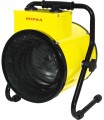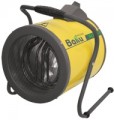Max. thermal output
The highest heating power produced by an industrial heater.
The maximum area that the unit can effectively heat directly depends on this parameter (see below). Even if it is not indicated in the specs, it can be approximately determined from the calculation that for heating 1 m² of a room with a standard ceiling height of 2.5 m and good thermal insulation will require 100 W of thermal power. If the ceiling height is significantly different, then the power required for heating can already be withdrawn from the volume of the room — every 2.5 cubic metres of volume will require the same 100 W (and the volume is found by multiplying the area by the height of the ceiling). There are also more complex formulas for the most accurate calculation, taking into account the degree of thermal insulation, the temperature difference between inside and outside the room, etc.; they can be found in special sources.
Note that in electric models (see "Power supply"), the maximum thermal power, in addition to all of the above, also determines the total power consumption of the unit: the power consumption (see below) cannot be less than the thermal output (usually, it is somewhat higher due to for the removal of part of the energy for the operation of the fan). In devices with a water circuit, the actual thermal output depends on the temperature of the coolant at the inlet and outlet. Therefore, in the characteristics, a certain standard value is usually indicated, and in t...he notes, it is specified for which temperatures it is relevant (for example, 90 ° / 70 °).
Max. heating area
A very conditional parameter that slightly characterizes the purpose by the size of the room. And depending on the height of the ceilings, the layout of the room and the equipment, the actual values may differ significantly. Nevertheless, this item represents the maximum recommended area that the heat gun can effectively heat.
When determining the maximum area, usually, a universal formula is used that is valid for all heaters: 1 m² of floor space in a room with a standard ceiling height of 2.5 m requires 100 W of thermal power. Therefore, if the ceiling height differs markedly from this value, the actual heating area should be recalculated; for more details on scaling, see “Maximum thermal output".
Increase in air temperature (ΔT)
This parameter describes the difference between the air temperature at the inlet to the heater and the outlet temperature — in other words, by how many degrees the air temperature rises when passing through the unit. The higher ΔT, the hotter the outgoing air will be and the more attentively it is necessary to observe safety measures (do not place the device near flammable and heat-sensitive materials, prevent people from being in the immediate vicinity of the gun exit, etc.).
Rated current
The current consumed by the heat gun during normal operation. This parameter is useful primarily for assessing the load on the mains that occurs during the operation of the unit and organizing the appropriate connection. In particular, the rated current of the fuse installed in the connection circuit cannot be lower than the total rated current of the connected load — otherwise, the power will be turned off. Heat guns (primarily electric, see "Power supply") are quite high consumption consumers in terms of current.
Power consumption
The power consumed by the electrical components of the industrial heater during operation.
This parameter allows, first of all, to assess the load on the power grid and the suitability of the available power for the normal operation of the unit. It is relevant for all types of modern industrial heaters (see "Power supply"). However, it is worth noting that in some electric models, the power consumption is indicated for the ventilation mode. In this mode, the heating element is not activated, and the power consumption is extremely low — a few tens of watts. In such cases, the total power can be estimated from the maximum thermal output (see above) — in electrical models, these parameters practically do not differ from each other.
Airflow
The maximum amount of air that an industrial heater can pass through itself in a certain time.
This parameter is associated with an increase in air temperature (see above): at constant power, higher performance usually corresponds to a smaller temperature difference. Accordingly, a more efficient industrial heater will heat the entire volume of the room faster, but the heating temperature will be lower. So, it is worth choosing according to this parameter, taking into account what is more important for you — a large temperature difference or a high heating rate.
Power adjustment
The method of adjusting the heating power provided in the design of the heat gun.
- Stepped. Step adjustment assumes the presence of several fixed power values, between which switching is carried out during the tuning process. The accuracy of such a setting is worse than that of a stepless one (see below), even in cases where there are quite a lot of fixed values. At the same time, perfect accuracy is far from always required, and setting a specific value is easier than selecting the position of the regulator with stepless adjustment.
-
Stepless. Stepless systems include adjustment systems that do not have fixed steps and allow you to set the power value in any range from minimum to maximum. Due to this, this setting is extremely accurate, although in some cases it is not as convenient as the stepped one described above.
Max. operating time
The longest time during which the industrial heater can work without interruption.
The value of this parameter depends on the power supply (see above). So, in diesel models, the operating time is usually indicated on one full tank, without refuelling. Note that this implies operation at the lowest power, with minimal fuel consumption, and in optimal environmental conditions. Therefore, when choosing a diesel heat gun for this parameter, it is worth taking a certain margin, or better, separately calculating the operating time at the highest fuel consumption: for this, the volume of the tank (see above) must be divided by the maximum consumption. If we are talking about a gas or electric model, then the maximum operating time usually means the time during which the unit can work without overheating.
Regardless of the type, the long maximum run time provides additional convenience when working with an industrial heater. At the same time, it does not always make sense to pursue the maximum value of this parameter: in fact, the need for continuous heating for a long time occurs quite rarely. In addition, many diesel models allow refuelling right during operation (and in others, the refueling break usually does not exceed a few minutes). Therefore, it is worth specifically looking for a heat gun with a long time of continuous operation only if such a feature is fundamentally important to you.
Features
—
Temperature control. The ability to change the heating temperature provided by the industrial heater. This function allows you to optimally adjust the operation of the device to the necessary conditions and heating intensity.
—
Thermostat. A thermostat is a device for maintaining the air temperature at the same level. The principle of operation of this device is as follows: when the required air temperature is reached, it automatically turns off the heating, and when it gets cold, it turns it on again until the air warms up sufficiently. The temperature of the thermostat operation, usually, is set by the operator of the heater.
—
Piezo ignition. The presence of a piezoelectric ignition system in the design of the industrial heater. In such systems, the spark necessary to ignite the fuel is generated by the operation of a piezoelectric generator, and its operation is based on the use of a special material that, when bent, generates an electric current. It means that no external power is required for ignition — the necessary energy is generated by the operator himself when the button is pressed. In addition, piezoelectric systems are considered very convenient for several other technical reasons. They are found mainly in gas industrial heaters (see "Power supply") because, for diesel fuel, such ignition is poorly suited.
—
Complete fuel combustion. This feature is found in gas and diesel models (see "Power supply"). It means that the fuel in the combustion chamber of the heater burns out completely, without forming soot and other by-products and practically without creating unpleasant odours. In addition, it has a positive effect on efficiency. This feature is especially important for diesel units because diesel and many types of liquid fuels are "dirtier" than gas and more prone to soot. Smokeless combustion facilitates the use of heaters in rooms where there are people — however, note that it does not cancel the requirements for good ventilation, since combustion products still need to be removed from the air.
— Fan mode. The ability to operate the heater in the ventilation-only mode, when the device circulates air but does not warm it up. The purpose of this function is obvious: situations when the room is already warm enough, or heating is not required for other reasons.
— Fuel level indicator. The presence in the design of a diesel heater of a sensor that signals the amount of fuel in the tank. The design and operation of this sensor may vary from model to model: in some devices, it constantly displays the remaining fuel; in others, it plays the role of an alarm and turns on only when the fuel level drops below a certain value. However, this feature makes it easier to monitor the condition of the unit and prevents troubles associated with unexpected emptying of the tank.
— Air filter. The presence of an air purification filter in the design of a diesel heater. One of the “weaknesses" of such units is the nozzles that supply the fuel-air mixture to the combustion chamber; contaminants that enter these nozzles clog them and can even disable them. The air purification filter prevents such troubles: it traps dust, sand and other mechanical impurities, ensuring stable operation and durability of the injectors.

